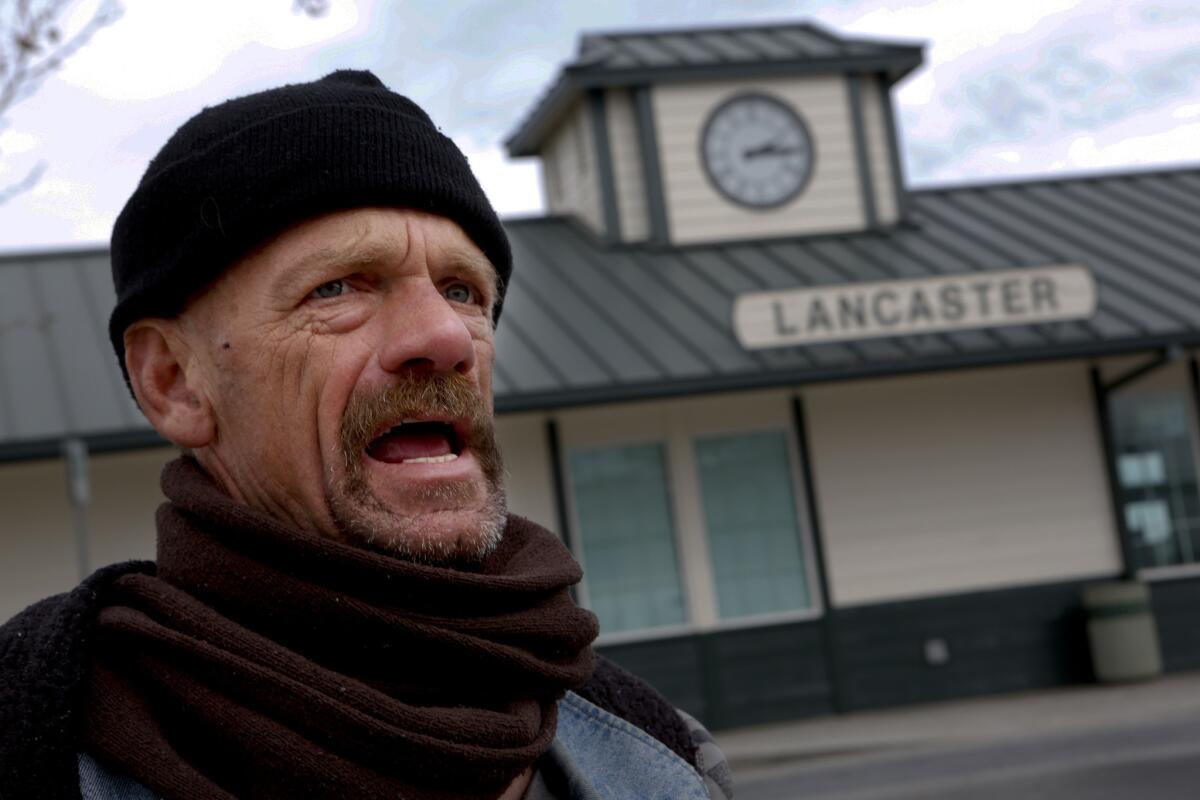Antelope Valley homeless population takes unexplained jump

- Share via
The city of Lancaster is the end of the line for Metrolink commuter trains northbound from Los Angeles and Glendale.
So when the homeless count in the Antelope Valley quadrupled, officials suspected that someone in Los Angeles was engaging in a railway version of “Greyhound therapy,” putting transients on the train to whisk them away.
“We’ve had people getting off the train with all their worldly possessions on them,” said Lee D’Errico, the head of Lancaster’s public safety department.
Vice Mayor Marvin Crist said homeless people were being given train tickets out of Los Angeles.
Full coverage: Homeless in America
But shelter operators and homeless people said last week that they see little evidence of that. Many of the homeless people were from Lancaster or had friends and families there.
Although an occasional transient turns up with a medical band on his wrist, suggesting patient dumping, L.A. emigres said they have found Lancaster on their own as a clean and peaceful alternative to life in the big city.
“L.A. is crazy, man. It’s chaotic,” said Byron Thomas, 31, a former Marine.
“We do have one of the cleaner shelters in Los Angeles County,” said Sheldon Morris, a human resources intern at Grace Resource Center’s shelter. “It’s word of mouth.”
The Antelope Valley’s homeless population went from 1,412 in 2011 to 6,957 last year, a rate of increase far above the 15% figure countywide. Officials said the steep jump, based on a one-night count 13 months ago, could reflect a more accurate tabulation and not a population explosion.
With shelter capacity of only 250, Lancaster opened an overflow space Jan. 6 at the Antelope Valley Fairgrounds, and the City Council asked its lawyers to explore getting more “equitable” funding from the Los Angeles Homeless Services Authority.
On Wednesday, no obviously homeless people disembarked from the afternoon trains. Martin Freeman, 50, a parolee walking near the station, said he slept on his mother’s lawn in Lancaster.
Grace Resource Center, a faith-based group, runs a $1.2-million-a-year program that oversees the Inn Between, a low-slung concrete shelter on the edge of town. It offers hot meals, provided by local churches and the L.A. Regional Food Bank, and computer classes.
Steve Baker, the center’s executive director, said 39% of the area’s homeless are veterans “and that number is going up.” Others are parolees with restrictions that keep them from staying with family.
The cities of Palmdale and Lancaster kicked in $8,000 each this year to open the fairgrounds shelter, which takes as many as 80 men. Women and children stay at the Inn Between.
Sue Broulik, the shelter supervisor, said she gets seven or eight calls a day from local families who have lost their jobs and homes. The December unemployment rate was 12.5% in Lancaster and 11% in neighboring Palmdale, substantially higher than the statewide rate of 8.3%.
Some people said they heard Lancaster has cheap housing, but Broulik said, “There really isn’t any.”
Mitchell Johnson, 56, said he built airplanes for Lockheed Martin Corp. in Palmdale but has been out of a job since a subsequent employer moved to Rancho Cucamonga.
Dwayne, from Compton, said he found the Lancaster shelter on Google. “The cleanliness is good here, and you’ve got church ladies bringing enchiladas from their homes,” said Dwayne, who commutes by train to a job in Los Angeles and asked that his last name be withheld.
Rod Smith, the shelter’s director of men’s services, said a woman in a white nursing outfit dropped off a Ventura County man with mental health issues. A man in a wheelchair was left by the side of the road.
“We’re like, ‘Whoa, can he walk?’” Smith said, clapping his hands on top of his head and laughing at the outrageousness of the situation.
As the desert light faded, Smith addressed a sea of more than 40 sun- and wind-chapped faces, reeling off a long list of rules, including no alcohol, drugs or “spice,” a potpourri that some homeless people smoke.
“OK, gentlemen, we’ve got a big number here today,” Smith said. “I’m asking you to make a extra effort to show grace to each other.”
The men piled on a yellow school bus that crisscrossed the wide highways to the fairgrounds, coming to a stop at a scarlet, barnlike building. Inside, the men set about making up their cots, then tucked towel rolls under their arms for another bus ride to the showers.
“You’re missing the real story here,” said Richard Britton, 54. Britton said he moved to Lancaster seven years ago “for love” but his job fell through and now, “I can’t even find a job pushing a broom.”
More to Read
Sign up for Essential California
The most important California stories and recommendations in your inbox every morning.
You may occasionally receive promotional content from the Los Angeles Times.










